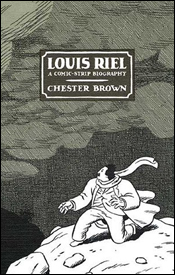 Louis Riel: A Comic-Strip Biography
Louis Riel: A Comic-Strip Biography
Writer: Chestor Brown
Artist: Chestor Brown
By Paul De Angelis
Because of our short history and the small part we've played on the world stage, Canada hasn't had a very exciting history, no matter how much we pretend otherwise. So when controversial figures come along, we latch onto them. Louis Riel was such a figure. He was a leader to the Métis when their land rights clashed with the plans of the Canadian Government in Ottawa.
But as controversial as Riel was, reactions to him were predictable, as they were almost always predicated along linguistic lines. The Métis and French revered him, while the English reviled him. We're not as beholden to our native language when passing judgment on Riel these days, and there's certainly no question where writer/illustrator Chester Brown's sympathies lie. He shows us how Riel and the Métis were victims of the treaty-breaking at which the Anglophones were experts. Even Canada's first Prime Minister, John A. McDonald, is shown to be a conniving man who negotiated on bad faith.
Louis Riel: A Comic-Strip Biography covers almost twenty years, but only those years that contained Riel's contributions to the rebellions in Manitoba and Saskatchewan. Brown's endnotes are a good indication of how much work and research went into this graphic biography. It's impressive that, by pinpointing where he has deviated from known history, it becomes clear how many thoughtful decisions Brown made for the sake of the narrative. Yet few of them are so significant as to call the book's overall accuracy into question.
Louis Riel is a very structured work. There are about 240 pages, each one adhering to Brown's six-panels-per-page format. The black and white drawings are simple (Brown sites Little Orphan Annie and Tintin as his inspiration), and some of the panels containing no backgrounds at all. But this is not a criticism, as this is a content-oriented work, and the art does have a quiet power of its own.
Its greatest strengths, and what makes Louis Riel so engrossing, is its fast pace and narrative control. There are long stretches where Riel doesn't even appear; instead, Brown shows us interactions between other people connected with those events of the 1870s and '80s. But it never becomes confusing, nor does the reader lose track of the many characters. Admittedly, Brown includes captions to identify times and people, but they're always short and to-the-point. There isn't an over-reliance on captions to carry the story.
There are a couple of weak sections in the book. Part Two changes scenes too often because Brown covers too many years too quickly. As in any biography where the listing of facts takes precedence, the narrative flow is interrupted and you feel distanced from the action. And Part Four brings the story to an accurate but dull conclusion as we're taken through the relatively unexciting trial of Riel.
Overall, however, Brown has accomplished what too few comic book artists even attempt: He's used actual history as his inspiration. Too bad it's Canadian history.

